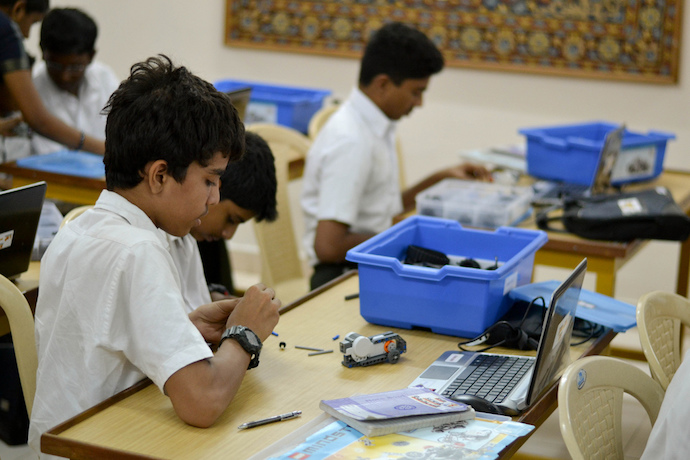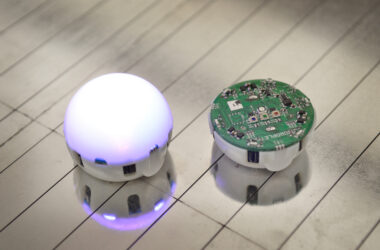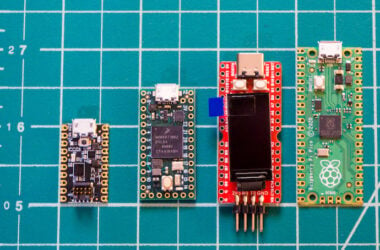As the sixth grade class meanders into my computer lab and takes their seats, I begin working the room. Arms folded, I casually make small talk, but I also begin drilling the students on the concepts we have recently covered. What is decomposition again? An eager hand goes up. Hmmm… How does that work? Is it just a list of steps? Explain what you meant there…
Our robotics unit has many areas of focus, although the basics of Computational Thinking is one of the more valuable cognitive skills I teach. On this particular day, this information is quite fresh for these 11 and 12 year-olds, and I am pleased with their answers. However, as the unit progresses, the teacher voice in my head has a few nagging doubts about how well they are actually mastering decomposition.
One of the higher order skills that I look for in my students is application of knowledge. After presenting a new concept, asking students to practice the skill, and beginning the process of assessment, application is one of those mastery level skills on Bloom’s Taxonomy that teachers regularly aim for. Application really demonstrates that a student has internalized the lesson because they apply it to a new or unfamiliar situation.
I have found that what students do with a given problem holds more weight than what they can say about it. While observing them handle a problem, I watch for subtle changes in behavior and habit.
For example, after a recent lesson on pattern recognition, I was delighted to see a student using her shoe as an ad hoc measurement tool on a tricky robotics maze. She identified a pattern in how the robot traveled in relation to her shoe, and used the shoe to make estimations before programming.
One particular danger for teachers of technology is when students begin seeing the problem solving techniques they learn and technology literacy they gain as only living inside the Computer Science classroom. The information they learn becomes cognitively siloed, and as a result, they lose many of the benefits of technology education.
To explain, I need go no further than the traditional classroom layout of many schools. I teach my classes in a computer lab filled with desktop computers, robots, computer parts, and an old Atari 2600 console. Students enter, class happens, and then they file out to other spaces meant for science labs or evidence-based essay writing. While many schools have begun to diversify the spaces and boundaries of the STEM classroom, my school is like many others in that we still have firm divisions between classrooms and curricula.
In my eyes, problems begin to arise when these divided spaces mirror a division in the students’ understanding.
This year I began fighting against this habit and worked more closely with my colleagues to integrate computational thinking methods into other disciplines. Decomposition or breaking down large problems into smaller more manageable problems was an easy place to start.
Sixth grade is the year when word problems begin to vex many students in the math classroom. However, using highlighters to decompose has helped many students organize the problem cognitively before solving it. In our English classrooms, students also begin the process of writing evidence-based analysis in their five-paragraph essays. After working with the English teachers, students found it helpful to apply decomposition methods to tease apart the elements of complex writing prompts. Along with the efforts in my classes to decompose using flowcharts, students ended up applying decomposition to a wide range of assignments, many of them new territory.
What I am learning through these efforts is that the broad application of cognitive skills is mutually beneficial for both content area and technology teachers. Computational thinking lends itself easily to this kind of diversification, although there are other problem solving methods that also fit the bill.
Understandably, not every teacher is ready to move towards a problem and solution based curriculum, and these changes do take the place of other content. However, when students practice these skills, they begin to develop a more robust understanding of the work of problem solving. The hope is that wherever they see a problem in their lives and work, they will have a general framework for approaching it. This goes quite a long way to help quiet that nagging teacher voice, although as an educator I know that following that voice can lead to novel approaches in the classroom.
Learn More
Tips for teaching STEM
https://beneylu.com/pssst/en/stem-classroom/
https://www.edweek.org/tm/articles/2014/06/17/ctq_jolly_stem.html
https://www.edutopia.org/blog/stem-engagement-maker-movement-annmarie-thomas
How to teach computational thinking
https://www.wired.com/2016/09/how-to-teach-computational-thinking/
https://edtechmagazine.com/k12/article/2016/11/teaching-computational-thinking-first-step-bridging-stem-skills-gap
https://www.iste.org/explore/articleDetail?articleid=894&category=In-the-classroom&article=
https://code.org/curriculum/course3/1/Teacher










